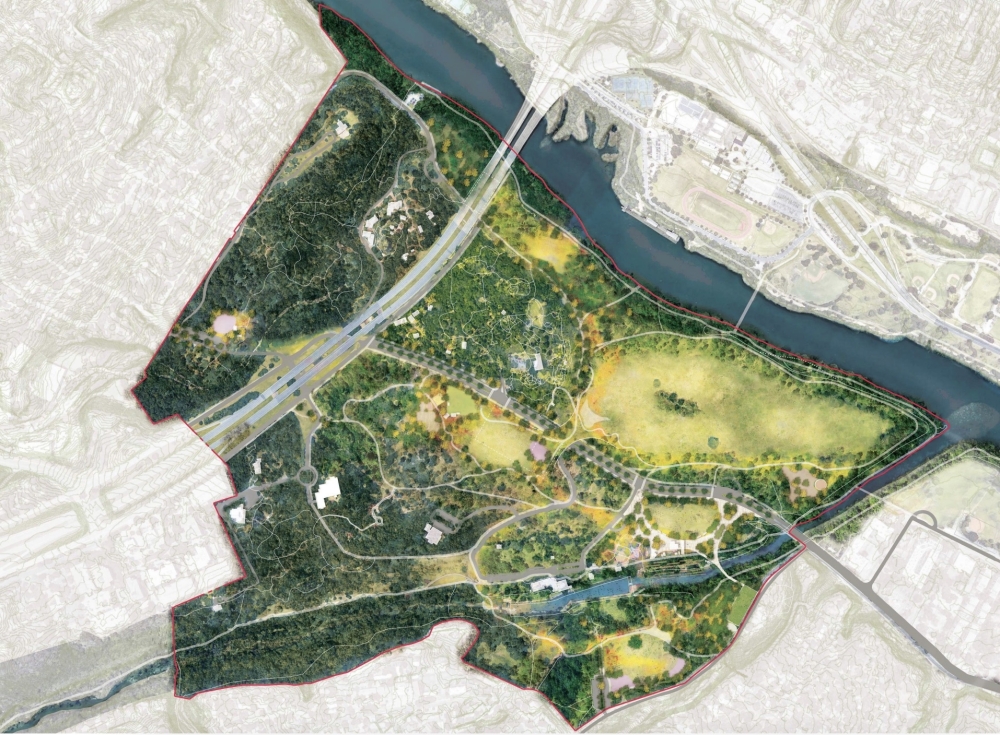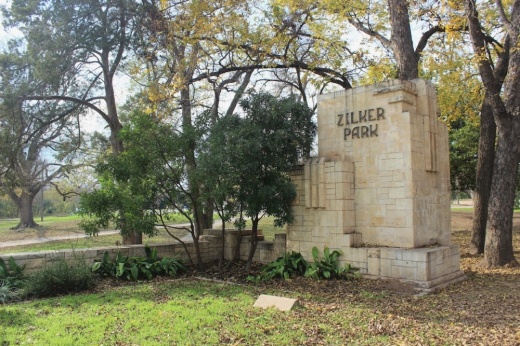The big picture
The Zilker Park Vision Plan has been in the works for years. If approved, the extensive plan would lay out the next several decades of environmental restoration, parkland improvements, facilities additions and mobility upgrades in the 351-acre park.
The document is in draft form and could be approved by city officials this summer following extensive public input and civic reviews.
Today, the draft plan includes a long list of proposed changes around Zilker. However, firm details on all updates, such as designs, costs, timelines and more, are not yet decided and would be handled individually as each item moves forward.
The specifics
Access to Zilker Park and getting around once there are key pieces of the vision framework. Mobility changes outlined in the draft vision plan include:
- Replacing most existing parking with three parking garages
- Building a land bridge over Barton Springs Road in the middle of the park
- Reducing Barton Springs Road to two lanes with parallel parking and adding more bus stops along the road
- Closing the Lou Neff Road loop to vehicle traffic, and making it a bike and pedestrian path
- Partially closing Columbus Drive and Andrew Zilker Road to vehicle traffic
- Building several new bridges for pedestrians and cyclists across Barton Creek
- Building a new bike and pedestrian bridge across Lady Bird Lake
- Realigning Stratford Drive east of MoPac
- Removing parking on the Butler Landfill for ecological restoration
- Adding an internal shuttle service around the park and extending the Zilker Eagle train route on the park's north side
- Adding an external shuttle route to carry visitors to and from downtown

During initial public engagement about Zilker Park about two years ago, residents broadly pointed to parking areas as a top area of need. Planners said they took that feedback into account, and that the garage idea aims to lessen vehicle impacts to account for future transit upgrades and Austin's environmental goals.
However, shifting from the parking scattered around Zilker to a handful of garages has proven to be one of the more divisive elements of the vision plan so far. The number and location of potential garages are subject to change, but the plan calls for an underground facility in the park's center, one to the west underneath MoPac and one to the east off Azie Morton Road.
Planners estimate the garages would provide the same amount of parking as all the paved and unpaved spaces in use throughout Zilker today—nearly 2,500 spots—while consolidating vehicle traffic and removing several acres of impervious cover.
During a May 11 City Council committee meeting on mobility, officials questioned aspects of that outline while highlighting the need for new parking options. Mayor Pro Tem Paige Ellis noted the parking situation and related enforcement can already be unworkable as the city receives frequent reports of people jumping curbs and pulling onto parkland when spaces are scarce.
Design Workshop Principal Claire Hempel, the project's lead consultant, said planners believe demand for parking at Zilker will continue to rise. Instead of adding more spaces though, the vision document calls to maintain parking levels mainly in the three garages as other mobility and transit options fall into place.
"One could hypothesize that, ‘Well, we need to provide more parking,’ but that is not generally a best practice in park design," Hempel said.
Greg Montes, the parks and recreation department's vision plan project manager, said the change could help reduce congestion and support the local environment by keeping car pollutants in garages with modern treatment systems in place. Today, he said pollutants can run off into Zilker's parkland and nearby waterways untreated.
Speaking on another controversial piece of the plan, District 5 Council Member Ryan Alter said more consideration must be given to the concept of reducing lanes along Barton Springs Road given its importance for West and South Austin drivers. And Ellis said the city's not looking to add more lanes, but that either maintaining or cutting lanes should be further analyzed for the visitors' safety.
"If we can figure out a way to make traffic flow better I’m willing to have those conversations. But I know we definitely need more of the bike and pedestrian infrastructure as has been showcased by the new shared-use path going in around the botanical garden," she said.
The city's Urban Transportation Commission unanimously recommended earlier this year that any upcoming traffic studies along Barton Springs Road prioritize multimodal access and visitors' use of Zilker Park, rather than vehicle needs along the corridor.
Bridge replacement
Separate from the vision planning process, the city has been looking for years to either rehab or replace the Barton Springs Road Bridge that serves as a key connector in the park.
Planners now say a full bridge replacement is the best path forward, and Austin is moving ahead on plans to tear down the historic structure and build a new one in its place. An initial outline includes the same four lanes for vehicle traffic that exist today plus expanded bike lanes and sidewalks.

While city engineers don't believe the bridge is in immediate danger of structural issues or collapse, it has been deemed "functionally obsolete" and challenging for bikes and pedestrians to traverse. Ellis said changes are needed to improve a bridge layout that can prove unusable, and dangerous, today.
"Situations where people may be trying to walk or bike in spaces that are not built for them, where we have buses and high-speed traffic coming through, that is a very deadly equation," she said.
City officials recently invited community members to comment on the bridge replacement and three initial concepts for the new structure. Further discussions and reporting are expected later this year before the project moves into an official design phase; construction could begin in 2025 or later. The three replacements are projected at $10.2 million-$18.1 million, although funding must still be identified.

Get involved
Formal feedback on the draft Zilker Park Vision Plan is now closed following a public engagement period of more than two years that garnered thousands of comments from across the city. However, the draft is still scheduled for further consideration before its potential approval by City Council in July.
After moving through reviews by multiple city boards and commissions this spring, the volunteer parks and recreation board is set to take another look at the plan in the coming weeks. Austinites can also contact their council members about the plan and speak at the council meeting when the plan is up for a final vote later this summer.
More information is available from project team members, who can be contacted by email or by calling 512-974-9458.





